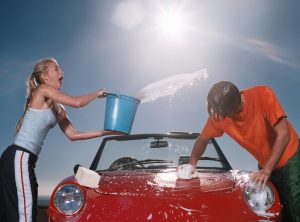
- Keep your cool – Staying cool is important not just for you, but also for your car. Beyond checking the level of coolant fluid in your car, be sure to inspect the state of the hoses and coolant reservoir to keep an eye out for leaks. Squeeze the hoses (when the engine is cool) from time to time to make sure they feel firm and not excessively squishy or soft
- Tighten up your belt – There usually is a serpentine belt that runs between the alternator, the fan and several other components that can become loose or deteriorate over time. It needs to be in good condition and at the right amount of tension, so if you see cracks or small pieces missing, it’s time to replace the belt.
- Clear your vision – Summer rain showers really can do a number on wearing out your windshield wipers, creating nasty streaks across your windshield and affecting your vision while driving. Replacing your wipers is not costly but can be a fiddly operation, so you may want to inquire about wiper installation during your regular oil changes or a dealership visit.
- Stay hydrated – Check oil, brake, power-steering and windshield-washer fluids regularly, as these liquids are in constant use and are key to your vehicle functioning properly.
- Crank the air – Air-conditioning is a summer essential, so if the system hasn’t been working properly in recent months, summer certainly is the time to get serious about repairing any leaks or issues. Have a qualified mechanic fix the leak before paying to have the air-conditioning system recharged.
- Clean your filters – Summer is the time to take out your air filter to give it a good cleaning, or buy a new filter if needed. Many modern cars also have pollen filters or cabin filtration systems, so be sure to take a look at those, too. And as always, when in doubt, consult a qualified technician.
- Under pressure – Tires really need to be checked regularly all year round, and summertime is no exception. Pressures must be correct (consult the manual for levels specific to your vehicle), treads should be free of stones, stray nails and the like, and all four tires should be in good condition (meaning no cracks, no uneven wear and plenty of tread depth). Don’t forget to also check your spare to ensure it is usable.
- Throw some shade – Don’t underestimate the greatness of a dashboard sunshade for those times you are not driving but the car is still out in the sun. It helps protect the dashboard and interior against ultraviolet rays and can help prevent fading over time, and in the short-term, it helps the cabin stay a little cooler.
- Keep it clean – Those long, balmy evenings when the sun seems to hang low for hours can be lovely, but also hazardous if your car’s windshield is dirty. The haze on your windshield can diffuse the light and make things hard to see, so keep your car’s exterior clean. Things look much sharper after your car has had a good wash, and regular washings protect the paintwork from the sun’s rays.
- Plan accordingly – It’s hot out there, so keep both the driver and passengers happy by keeping everyone hydrated. Plan road trips by making lists of what you’ll need to keep everyone in the car happy while on the journey (examples: sunglasses, travel mugs, games for the kids, snacks, phone chargers and more), and don’t forget to have those just-in-case items like a flashlight and small tool kit handy. Be sure your license and insurance are up to date, and that you’re keeping tabs on your vehicle’s scheduled service.
Source: Autotrader


